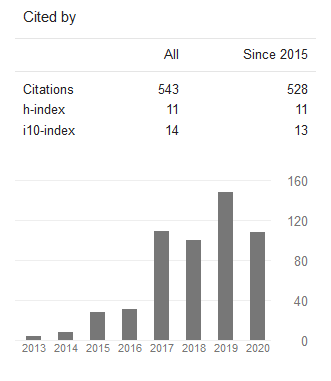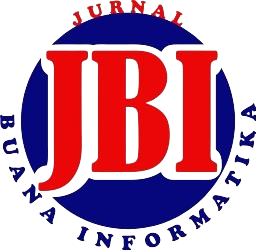Perbandingan Pembobotan Kriteria dan Seleksi Kriteria pada Pengelompokan Kinerja Karyawan dengan Fuzzy C-Means
DOI:
https://doi.org/10.24002/jbi.v12i1.4341Abstract
Abstract. Comparison of Weighted Criteria and Selection Criteria for Employee Performance Grouping with Fuzzy C-Means. The development of information technology makes it easier for companies to do many things and affect company operations. One of the objects affecting the company development is employees. Employees’ performance can be observed from their discipline, honesty, cooperation, and work quality. The purpose of this study is to group the employees based on their performance using fuzzy c-means. There are two kinds of clustering explained in this paper, i.e., clustering with feature weighting and clustering with feature selection. Using the feature weights of 25%, 30%, 25%, and 20% for work discipline, honesty, cooperation, and work quality, respectively, the clustering with feature weighting gives an accuracy rate of 0.8462. While using feature selection, the fuzzy c-means give 1, where the work discipline and honesty are the critical features in clustering. Therefore, we find that honesty is the most essential feature to cluster the employees based on their performance from this research.
Keywords: clustering, employees, fuzzy c-means, feature weighting, feature selection
Abstrak. Perkembangan teknologi informasi mempermudah perusahaan dalam melakukan banyak hal dan mempengaruhi operasional perusahaan. Salah satu objek yang mempengaruhi operasional perusahaan adalah kinerja karyawan. Penilaian kinerja karyawan didasarkan pada empat kriteria, yaitu kedisiplinan, kejujuran, kerja sama, dan kualitas kerja, Tujuan penelitian ini untuk melakukan pengelompokan karyawan dengan fuzzy c-means. Pengelompokan yang dilakukan dalam penelitian ini terdiri dari dua macam, yaitu pengelompokan dengan pembobotan kriteria dan pengelompokan dengan seleksi kriteria. Dengan bobot sebesar 25%, 30%, 25%, dan 20% untuk kriteria kedisiplinan, kejujuran, kerja sama, dan kualitas kerja, pengelompokan dengan pembobotan kriteria menghasilkan akurasi sebesar 0.8462. Pengelompokan FCM dengan seleksi kriteria menghasilkan kriteria kedisiplinan dan kejujuran merupakan dua kriteria yang penting dalam pengelompokan karyawan, dengan akurasi sebesar 1. Dari hasil perbandingan dua macam pengelompokan tersebut didapatkan bahwa kejujuran merupakan kriteria terpenting dalam pengelompokan karyawan berdasarkan kinerjanya.
Kata Kunci: pengelompokan, karyawan, fuzzy c-means, pembobotan kriteria, seleksi kriteria
References
C. Januari, “Pengaruh penilaian kinerja terhadap kepuasan kerja dan prestasi kerja (Studi pada karyawan PT. Telekomunikasi Indonesia, Tbk wilayah Malang),” J. Adm. Bisnis S1 Univ. Brawijaya, vol. 24, no. 2, pp. 1-8, Jul. 2015.
I. H. Rani and M. Mayasari, "Pengaruh penilaian kinerja terhadap kinerja karyawan dengan motivasi sebagai variabel moderasi,". J. Ak. Eko. dan Manaj. Bisnis, vol. 3, no. 2, pp. 164-170, Dec. 2015.
M. Dousthagh, M. Nazari, A. Mosavi, S. Shamshirband, and A. T. Chronopoulos, “Feature weighting using a clustering approach,” Int. J. Model. Optim., vol. 9, no. 2, pp. 2–6, Apr. 2019.
S. Q. Shinta Palupi, Reza Andrea, “Analisis cluster gaya belajar siswa sekolah menengah kejuruan dengan pendekatan metode k-means dan fuzzy c-means,” J. Penelit. Komun. dan Opini Publik, vol. 21, no. 2, pp. 102–110, Des. 2017.
C. L. Simbolon, N. Kusumastuti, and B. Irawan, “Clustering lulusan mahasiswa matematika fmipa untan pontianak menggunakan algoritma fuzzy c - means,” Bul. Ilm. Mat. Stat. Dan Ter., vol. 02, no. 1, pp. 21–26, Mar. 2013.
M. Yang, “A Feature-reduction fuzzy clustering algorithm based on feature-weighted entropy,” vol. 26, no. 2, pp. 817–835, Apr. 2018.
K. Polat, “Classification of parkinson’s disease using feature weighting method on the basis of fuzzy c-means clustering,” Int. J. Syst. Sci., vol. 43, no. 4, pp. 597-609, Apr. 2012.
M. Hashemzadeh, A. Golzari Oskouei, and N. Farajzadeh, “New fuzzy c-means clustering method based on feature-weight and cluster-weight learning,” Appl. Soft Comput. J., vol. 78, pp. 324–345, May 2019.
T. M. Nguyen and Q. M. J. Wu, “Online feature selection based on fuzzy clustering and its applications,” IEEE Trans. Fuzzy Syst., vol. 24, no. 6, pp. 1294–1306, Dec. 2016.
F. Hermawati Astuti, “Analisa cluster,” dalam Data Mining, edisi ke-1, Yogyakarta, Indonesia: Andi, 2013, ch. 5.
S. Chormunge and S. Jena, “Correlation based feature selection with clustering for high dimensional data,” J. Electr. Syst. Inf. Technol., vol. 5, no. 3, pp. 542–549, Dec. 2018.
S. J. Chang-Chien, Y. Nataliani, and M. S. Yang, “Gaussian-kernel c-means clustering algorithms,” Soft Comput., vol. 25, no. 3, pp. 1699–1716, Feb. 2021.
S. Kusumadewi and H. Purnomo, "Fuzzy clustering," dalam Aplikasi logika fuzzy untuk pendukung keputusan, 2nd ed. Yogyakarta, Indonesia: Graha Ilmu, 2010, ch. 3.
X. Tang et al., “Feature selection algorithm based on k-means clustering,” 2017 IEEE 7th Annu. Int. Conf. CYBER Technol. Autom. Control. Intell. Syst. CYBER 2017, pp. 1522–1527, Aug. 2017.
J. Cai, J. Luo, S. Wang, and S. Yang, “Feature selection in machine learning: A new perspective,” Neurocomputing, vol. 300, pp. 70–79, Nov. 2017.
Downloads
Published
Issue
Section
License
Copyright of this journal is assigned to Jurnal Buana Informatika as the journal publisher by the knowledge of author, whilst the moral right of the publication belongs to author. Every printed and electronic publications are open access for educational purposes, research, and library. The editorial board is not responsible for copyright violation to the other than them aims mentioned before. The reproduction of any part of this journal (printed or online) will be allowed only with a written permission from Jurnal Buana Informatika.
This work is licensed under a Creative Commons Attribution-ShareAlike 4.0 International License.










